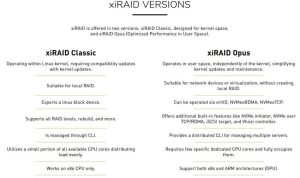Growing Xinnor Family with xiRAID Opus Software for User Space and Enhancing xiRAID Classic with V4.1
Boasts broader array of integrated functionalities, including built-in features such as NVMe initiator, NVMe over TCP/RDMA, iSCSI target, and Vhost controller.
This is a Press Release edited by StorageNewsletter.com on April 18, 2024 at 2:02 pmXinnor Ltd. announces the release of xiRAID Opus (Optimized Performance in User Space), a high-performance software RAID engine designed for disaggregated infrastructures and virtualized environments.
Click to enlarge
This release signifies a strategic evolution of the xiRAID brand, with the firm’s rebranding its kernel-space RAID implementation to xiRAID Classic, while introducing xiRAID Opus, based on the SPDK framework and operating in user space.
xiRAID Opus 1.0.0 represents a milestone in storage technology advancement, offering performance and features to meet the demands of modern data environments. Operating in user space, Opus offers a streamlined and independent setup compared to Classic, which relies on kernel dependencies. This architectural variance enables Opus to adapt more readily to system updates and simplifies maintenance, as it does not require compatibility adjustments with kernel updates.
Furthermore, xiRAID Opus boasts a broader array of integrated functionalities, including built-in features such as NVMe initiator, NVMe over TCP/RDMA, iSCSI target, and Vhost controller. These features facilitate direct connectivity to modern storage technologies, without relying on external components, enhancing efficiency and flexibility in networking and virtualization scenarios. Additionally, Opus is compatible with ARM architectures, allowing its deployment on ARM-based DPUs like BlueField3 from Nvidia.
In parallel with the launch of xiRAID Opus, xiRAID Classic has received an update to version 4.1. This release reaffirms xiRAID Classic’s position as the go-to solution for Linux kernel block devices.
xiRAID Classic features include:
-
Support for HA: the possibility to build a HA cluster of server nodes with shared storage, where in case of one node failure, the RAIDs are automatically migrated to the survived server, avoiding data loss and also service downtime.
-
Adaptive merge: Merge feature is the possibility to buffer and combine multiple sequential writes into a single one, to reduce the number of read-modify-writes and ultimately improve performance. While it was already available on previous xiRAID Classic releases, with 4.1 Xinnor is upgrading this feature to operate dynamically, meaning that the RAID engine is able to detect the workload and enable or disable Merge, to guarantee the best possible performance.
-
CPU affinity: this feature allows the system administrator to reserve some CPU cores to mission critical applications.
“We are excited to introduce both xiRAID Opus and the latest version, xiRAID Classic 4.1, to the market,” said Davide Villa, CRO. “With the addition of xiRAID Opus, the Xinnor product family is growing, catering to diverse storage needs. While xiRAID Opus is targeted at the user space for disaggregated or virtualized storage deployment, we also remain committed to keep enhancing xiRAID Classic to serve customers who require a fast RAID engine for kernel space applications. Both releases represent a significant leap forward in storage technology, offering unmatched performance, reliability and flexibility for our customers.”
For those eager to explore the full capabilities of xiRAID Opus, the company announces that the user manual and the product package are available for download on the firm’s website.














 Subscribe to our free daily newsletter
Subscribe to our free daily newsletter

